🐈🍁🍂🐾
🐈🍁🍂🐾

More Posts from Monstrous-mind and Others
🌌🏞️🏔️🍂🍁


mikkolagerstedt

🍃🍂🍁🌄🐈

🍂🍁🏔️🌨️🌌

Mark Basarab
🍁🍂🎃🍂🍁🍃🐈📚📖☕

Black Holes Dine on Stellar Treats!

See that tiny blob of light, circled in red? Doesn’t look like much, does it? But that blob represents a feast big enough to feed a black hole around 30 million times the mass of our Sun! Scientists call these kinds of stellar meals tidal disruption events, and they’re some of the most dramatic happenings in the cosmos.

Sometimes, an unlucky star strays too close to a black hole. The black hole’s gravity pulls on the star, causing it to stretch in one direction and squeeze in another. Then the star pulls apart into a stream of gas. This is a tidal disruption event. (If you’re worried about this happening to our Sun – don’t. The nearest black hole we know about is over 1,000 light-years away. And black holes aren’t wild space vacuums. They don’t go zipping around sucking up random stars and planets. So we’re pretty safe from tidal disruption events!)

The trailing part of the stream gets flung out of the system. The rest of the gas loops back around the black hole, forming a disk. The material circling in the disk slowly drifts inward toward the black hole’s event horizon, the point at which nothing – not even light – can escape. The black hole consumes the gas and dust in its disk over many years.

Sometimes the black hole only munches on a passing star – we call this a partial tidal disruption event. The star loses some of its gas, but its own gravity pulls it back into shape before it passes the black hole again. Eventually, the black hole will have nibbled away enough material that the star can’t reform and gets destroyed.

We study tidal disruptions, both the full feasts and the partial snacks, using many kinds of telescopes. Usually, these events are spotted by ground-based telescopes like the Zwicky Transient Facility and the All-Sky Automated Survey for Supernovae network.

They alert other ground- and space-based telescopes – like our Neil Gehrels Swift Observatory (illustrated above) and the European Space Agency’s XMM-Newton – to follow up and collect more data using different wavelengths, from visible light to X-rays. Even our planet-hunting Transiting Exoplanet Survey Satellite has observed a few of these destructive wonders!
We’re also studying disruptions using multimessenger astronomy, where scientists use the information carried by light, particles, and space-time ripples to learn more about cosmic objects and occurrences.

But tidal disruptions are super rare. They only happen once every 10,000 to 100,000 years in a galaxy the size of our own Milky Way. Astronomers have only observed a few dozen events so far. By comparison, supernovae – the explosive deaths of stars – happen every 100 years or so in a galaxy like ours.
That’s why scientists make their own tidal disruptions using supercomputers, like the ones shown in the video here. Supercomputers allow researchers to build realistic models of stars. They can also include all of the physical effects they’d experience whipping ‘round a black hole, even those from Einstein’s theory of general relativity. They can alter features like how close the stars get and how massive the black holes are to see how it affects what happens to the stars. These simulations will help astronomers build better pictures of the events they observe in the night sky.
Keep up with what’s happening in the universe and how we study it by following NASA Universe on Twitter and Facebook.
Make sure to follow us on Tumblr for your regular dose of space!
🔭🌌☄️🪐

2024 September 8
M31: The Andromeda Galaxy Image Credit: Subaru (NAOJ), Hubble (NASA/ESA), Mayall (NSF); Processing & Copyright: R. Gendler & R. Croman
Explanation: The most distant object easily visible to the unaided eye is M31, the great Andromeda Galaxy. Even at some two and a half million light-years distant, this immense spiral galaxy – spanning over 200,000 light years – is visible, although as a faint, nebulous cloud in the constellation Andromeda. A bright yellow nucleus, dark winding dust lanes, and expansive spiral arms dotted with blue star clusters and red nebulae, are recorded in this stunning telescopic image which combines data from orbiting Hubble with ground-based images from Subaru and Mayall. In only about 5 billion years, the Andromeda galaxy may be even easier to see – as it will likely span the entire night sky – just before it merges with, or passes right by, our Milky Way Galaxy.
∞ Source: apod.nasa.gov/apod/ap240908.html
🛰️🌌🪐☄️🍂🍁

Hubble Sees Possible Runaway Black Hole Creating a Trail of Stars
There's an invisible monster on the loose, barreling through intergalactic space so fast that if it were in our solar system, it could travel from Earth to the Moon in 14 minutes. This supermassive black hole, weighing as much as 20 million Suns, has left behind a never-before-seen 200,000-light-year-long "contrail" of newborn stars, twice the diameter of our Milky Way galaxy. It's likely the result of a rare, bizarre game of galactic billiards among three massive black holes.
The black hole lies at one end of the column, which stretches back to its parent galaxy. There is a remarkably bright knot of ionized oxygen at the outermost tip of the column. Researchers believe gas is probably being shocked and heated from the motion of the black hole hitting the gas, or it could be radiation from an accretion disk around the black hole. "Gas in front of it gets shocked because of this supersonic, very high-velocity impact of the black hole moving through the gas. How it works exactly is not really known," said van Dokkum.
This intergalactic skyrocket is likely the result of multiple collisions of supermassive black holes. Astronomers suspect the first two galaxies merged perhaps 50 million years ago. That brought together two supermassive black holes at their centers. They whirled around each other as a binary black hole.
Credit: NASA
🔭🌃🌌🍂🍁🐈
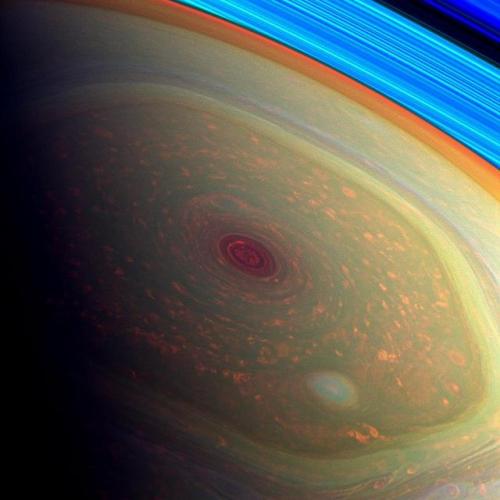
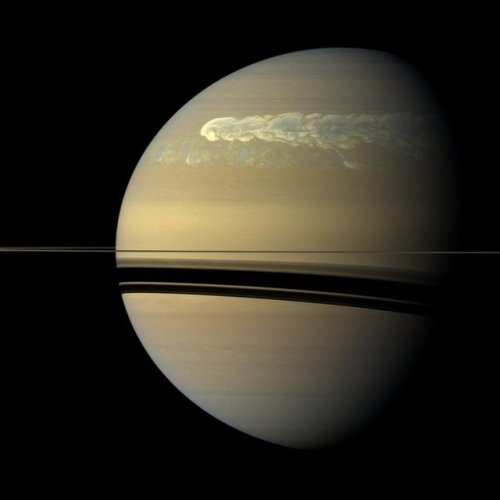
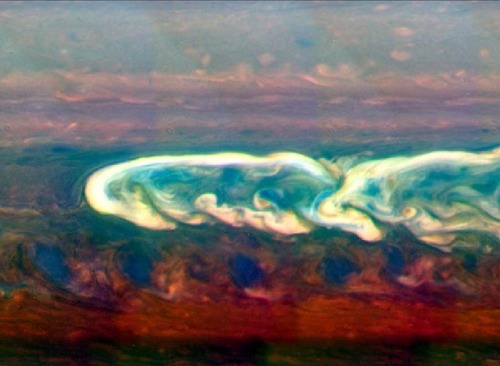



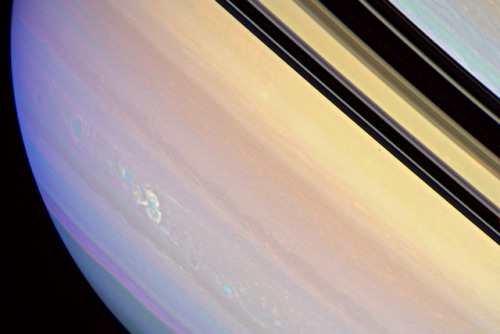

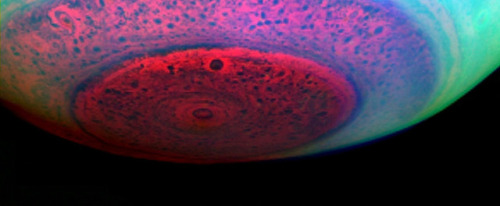
Saturn’s atmosphere exhibits a banded pattern similar to Jupiter’s, but Saturn’s bands are much fainter and are much wider near the equator. The nomenclature used to describe these bands is the same as on Jupiter. Saturn’s finer cloud patterns were not observed until the flybys of the Voyager spacecraft during the 1980s. Since then, Earth-based telescopy has improved to the point where regular observations can be made. The composition of the clouds varies with depth and increasing pressure.
The winds on Saturn are the second fastest among the Solar System’s planets, after Neptune’s. Voyager data indicate peak easterly winds of 500 m/s (1,800 km/h).
Thermography has shown that Saturn’s south pole has a warm polar vortex, the only known example of such a phenomenon in the Solar System. Whereas temperatures on Saturn are normally −185 °C, temperatures on the vortex often reach as high as −122 °C, suspected to be the warmest spot on Saturn.
Credit: NASA/JPL-Caltech/Space Science Institute and Kevin M. Gill
-
 miudacliche liked this · 3 months ago
miudacliche liked this · 3 months ago -
 megand120-blog liked this · 5 months ago
megand120-blog liked this · 5 months ago -
 yakupayd1n liked this · 5 months ago
yakupayd1n liked this · 5 months ago -
 annita89vfd98uwh liked this · 6 months ago
annita89vfd98uwh liked this · 6 months ago -
 mairem liked this · 6 months ago
mairem liked this · 6 months ago -
 dabiconcordia liked this · 6 months ago
dabiconcordia liked this · 6 months ago -
 mostlyanimals91 reblogged this · 6 months ago
mostlyanimals91 reblogged this · 6 months ago -
 omnomnom74 liked this · 6 months ago
omnomnom74 liked this · 6 months ago -
 gwenbeauregard liked this · 6 months ago
gwenbeauregard liked this · 6 months ago -
 gwenbeauregard reblogged this · 6 months ago
gwenbeauregard reblogged this · 6 months ago -
 intothewildfire reblogged this · 6 months ago
intothewildfire reblogged this · 6 months ago -
 andthewholebusapplauded liked this · 6 months ago
andthewholebusapplauded liked this · 6 months ago -
 hughbot liked this · 6 months ago
hughbot liked this · 6 months ago -
 welldigger62 liked this · 6 months ago
welldigger62 liked this · 6 months ago -
 run-mouse reblogged this · 6 months ago
run-mouse reblogged this · 6 months ago -
 earlgreyci reblogged this · 6 months ago
earlgreyci reblogged this · 6 months ago -
 earlgreyci liked this · 6 months ago
earlgreyci liked this · 6 months ago -
 qzqzz liked this · 1 year ago
qzqzz liked this · 1 year ago -
 pruplemonkeydishwasher liked this · 1 year ago
pruplemonkeydishwasher liked this · 1 year ago -
 screamingwombatgirl reblogged this · 1 year ago
screamingwombatgirl reblogged this · 1 year ago -
 screamingwombatgirl liked this · 1 year ago
screamingwombatgirl liked this · 1 year ago -
 wiltedhalcyon liked this · 1 year ago
wiltedhalcyon liked this · 1 year ago -
 barnalbkasfvene liked this · 1 year ago
barnalbkasfvene liked this · 1 year ago -
 dailyjanellemonae liked this · 1 year ago
dailyjanellemonae liked this · 1 year ago -
 noussommess reblogged this · 1 year ago
noussommess reblogged this · 1 year ago -
 sketchshelter liked this · 1 year ago
sketchshelter liked this · 1 year ago -
 alexforeverart liked this · 2 years ago
alexforeverart liked this · 2 years ago -
 i-am-the-hot-girl-that liked this · 2 years ago
i-am-the-hot-girl-that liked this · 2 years ago -
 arlenaaa reblogged this · 2 years ago
arlenaaa reblogged this · 2 years ago -
 albafilia liked this · 2 years ago
albafilia liked this · 2 years ago -
 agarotadela liked this · 2 years ago
agarotadela liked this · 2 years ago
My ambition is handicapped by laziness. -C. Bukowski Me gustan las personas desesperadas con mentes rotas y destinos rotos. Están llenos de sorpresas y explosiones. -C. Bukowski. I love cats. Born in the early 80's, raised in the 90's. I like Nature, Autumn, books, landscapes, cold days, cloudy Windy days, space, Science, Paleontology, Biology, Astronomy, History, Social Sciences, Drawing, spending the night watching at the stars, Rick & Morty. I'm a lazy ass.
222 posts
